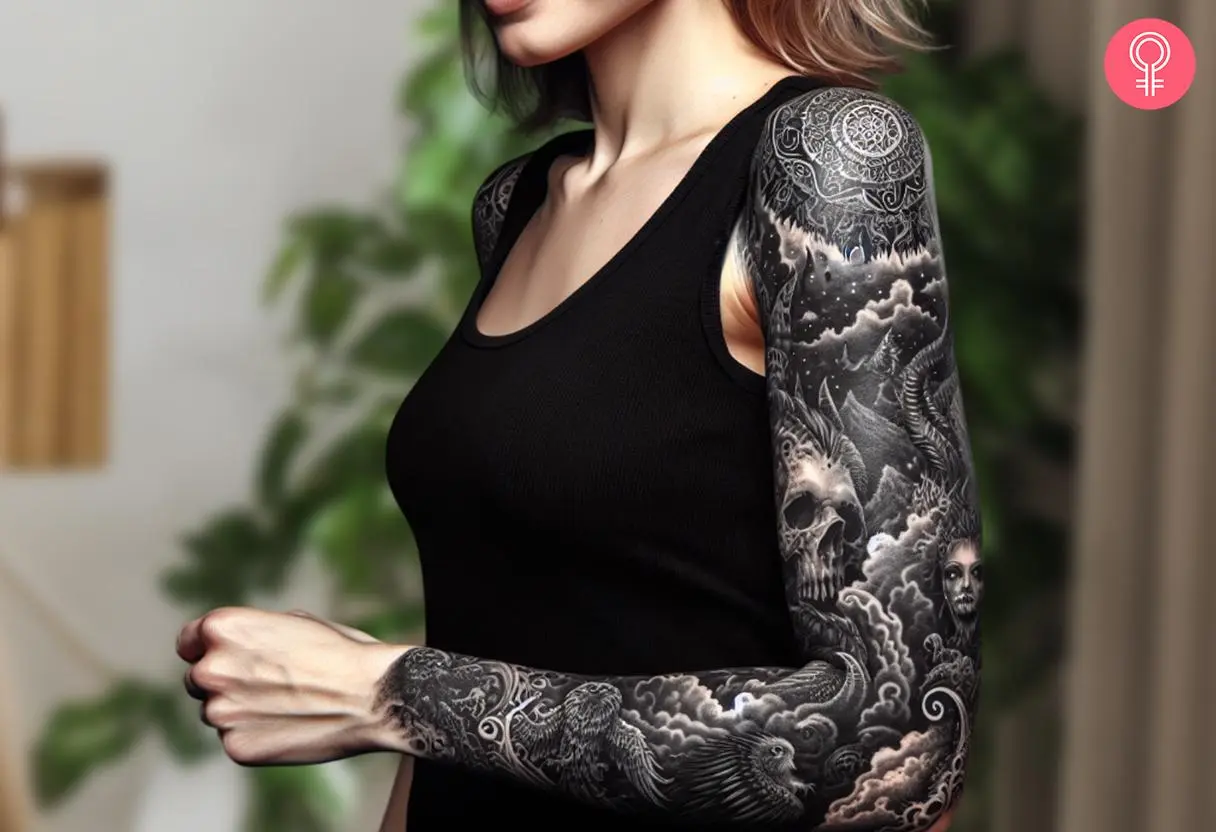
Satanic Tattoo Designs: Exploring the Symbolism and Art
Satanic tattoo designs, often misunderstood and sometimes controversial, represent a complex tapestry of symbolism, philosophy, and personal expression. These designs, ranging from subtle nods to overt declarations, are chosen by individuals for a variety of reasons, from challenging societal norms to celebrating personal freedom and individuality. This article delves into the world of satanic tattoo designs, exploring their history, symbolism, popular motifs, and the importance of understanding their meaning before committing to the ink.
The Historical Context of Satanic Imagery
Before exploring specific satanic tattoo designs, it’s essential to understand the historical context of Satanic imagery. The portrayal of Satan has evolved significantly over time. Originating from religious texts, Satan has been depicted as a tempter, a rebel, and even a tragic figure. These interpretations have heavily influenced artistic representations, including those found in tattoos.
It’s important to recognize that Satanism itself is not monolithic. There are various forms, some of which are atheistic and view Satan as a symbol of rebellion against oppressive authority, while others hold more traditional theistic beliefs. This variance directly impacts the meaning and intention behind satanic tattoo designs.
Common Satanic Symbols and Their Meanings
Several symbols are commonly associated with Satanism and frequently appear in satanic tattoo designs. Understanding these symbols is crucial for appreciating the depth and nuance of the artwork:
- The Sigil of Baphomet: Perhaps the most recognizable symbol of Satanism, the Sigil of Baphomet features an inverted pentagram containing the head of a goat. It represents the union of opposites and the embodiment of carnal desires. Many individuals choose this design to represent their embrace of individuality and rejection of societal constraints.
- The Inverted Pentagram: An inverted pentagram, with two points facing upwards, is another potent symbol often seen in satanic tattoo designs. It is often interpreted as the triumph of matter over spirit, or the descent of the spirit into the material world.
- The Leviathan Cross: Also known as the Satanic Cross, the Leviathan Cross is a symbol of balance and questioning authority. It is often associated with alchemy and represents the element of sulfur.
- The Number 666: Often referred to as the “Number of the Beast,” 666 is a number associated with Satan in the Book of Revelation. While often perceived negatively, some individuals embrace it as a symbol of defiance and rebellion.
- The Serpent: The serpent is a recurring motif in religious and mythological narratives. In the context of satanic tattoo designs, it can represent knowledge, temptation, and rebellion against divine authority, referencing the story of Adam and Eve.
Popular Satanic Tattoo Designs
Satanic tattoo designs are diverse and often combine various symbols and artistic styles. Here are some popular examples:
- Baphomet Tattoos: As mentioned earlier, the Baphomet is a widely chosen design. Variations include incorporating intricate details, geometric patterns, or combining it with other symbols.
- Inverted Cross Tattoos: The inverted cross can be depicted in various styles, from simple line work to elaborate gothic designs. Some individuals may choose to incorporate it with other imagery, such as flames or skulls.
- Lucifer Tattoos: Depictions of Lucifer, the fallen angel, are also common. These tattoos can range from realistic portraits to stylized representations of the angel’s descent.
- Theistic Satanism Inspired Tattoos: These satanic tattoo designs often incorporate demons and other infernal figures from various mythologies. They can be quite elaborate and detailed, reflecting a deeper understanding of theistic Satanic beliefs.
- Abstract Satanic Tattoos: Some individuals opt for more abstract interpretations of Satanic themes, using geometric shapes, dark color palettes, and symbolic imagery to create unique and personal designs.
Considerations Before Getting a Satanic Tattoo
Before getting any tattoo, especially one with potentially controversial symbolism, careful consideration is essential. Here are some crucial factors to consider:
- Personal Meaning: Understand the symbolism behind the design and ensure it resonates with your personal beliefs and values. A satanic tattoo design should be a reflection of your own identity, not a fleeting trend.
- Social Impact: Be aware that satanic tattoo designs can evoke strong reactions from others. Consider the potential impact on your personal and professional life.
- Artist Selection: Choose a reputable tattoo artist with experience in the style you desire. Look at their portfolio and ensure they understand the symbolism of the design. Discuss your ideas thoroughly to ensure the final result aligns with your vision.
- Placement: Consider the placement of the tattoo. Highly visible areas may attract more attention and scrutiny, while more discreet locations allow for greater privacy.
- Legality and Cultural Sensitivity: Be aware of any local laws or cultural sensitivities regarding tattoos. While freedom of expression is important, it’s also essential to be respectful of others’ beliefs and values.
The Art of Rebellion: Why Choose Satanic Tattoos?
For many, satanic tattoo designs are a powerful statement of rebellion against societal norms and religious dogma. They represent a rejection of traditional authority and an embrace of individual freedom. These tattoos can be a way to express nonconformity, challenge established power structures, and celebrate personal autonomy.
Furthermore, some individuals find empowerment in reclaiming symbols that have been historically demonized. By adopting satanic tattoo designs, they subvert the negative connotations associated with Satanism and transform them into symbols of strength, independence, and self-determination.
Finding Inspiration and Designing Your Own Satanic Tattoo
If you’re considering getting a satanic tattoo design, there are several resources available to help you find inspiration and create a unique design:
- Online Galleries: Numerous online galleries showcase a wide range of satanic tattoo designs. These galleries can provide inspiration and help you identify styles and symbols that resonate with you.
- Tattoo Artists’ Portfolios: Browse the portfolios of tattoo artists to find an artist whose style aligns with your vision. Look for artists with experience in creating dark art or occult-themed tattoos.
- Books and Art: Explore books on Satanism, occultism, and dark art for inspiration. These resources can provide a deeper understanding of the symbolism and history behind various motifs.
- Personalization: Don’t be afraid to personalize your design. Incorporate elements that are meaningful to you and reflect your individual beliefs and experiences. A truly unique satanic tattoo design is one that is deeply personal and meaningful.
The Enduring Appeal of Satanic Tattoo Art
Satanic tattoo designs continue to be a popular form of self-expression for individuals seeking to challenge norms, embrace individuality, and celebrate their personal beliefs. While often misunderstood, these tattoos represent a complex and multifaceted world of symbolism, philosophy, and artistic expression. By understanding the history and meaning behind these designs, individuals can make informed decisions and create meaningful and impactful artwork that reflects their unique identity.
Ultimately, the choice to get a satanic tattoo design is a personal one. It’s a decision that should be made with careful consideration, a thorough understanding of the symbolism, and a commitment to expressing one’s authentic self. [See also: Occult Tattoo Meanings] [See also: Dark Art Tattoo Styles] [See also: Controversial Tattoo Designs]

